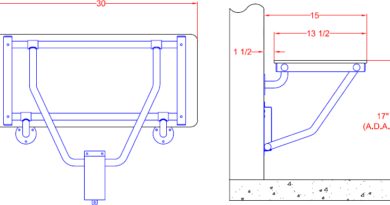How To Use A Snow Blower, Plus 10 Tips
**Articles may contain links that I earn compensation for if clicked and you make a purchase. As an Amazon Associate, I earn from qualifying purchases. These earnings do not actually impact the price of the product or service.
A snow blower is a machine that you use to clear snow from your driveway and sidewalks. There are two kinds of snow blowers: the single-stage snow blower and the two-stage snow blower. The difference between the two is the high-speed impeller present in the two-stage snow blower. It directs the snow out of a discharge chute. Thus, the two-stage snow blower is more effective on unpaved surfaces when you compare it with the single-stage snow blower.
Taking the snow blowers types 1 step further, you also have gas snow blowers and electric snow blowers.
Learning to use the snow blower effectively is not an easy task. In this article, we present you with a proper technique and ten tips so that you can get the job done efficiently and with ease.
Table of Contents
How to Use Your Snow Blower – Getting Started
The following are steps you should follow to get the maximum out of your snow blower with minimum effort.
Pre-Checks
There are a couple of checks that you need to perform before you start the machine.
– Check whether the tank has the fuel that is fresh and filled to the correct levels.
– Inspect your tires and make sure they have sufficient air.
– Check whether there are no unknown objects in your driveway that might hamper the machine’s functioning.
– Make sure that you are wearing appropriate clothing. It would help if you did not prefer clothes that might get stuck in the machine.
– Make sure the shear pins, belts, skid shoes, and scraper blades of your engine are intact.
– Thoroughly read the manual that comes with the snow blower and make sure that you know all the controls.
Planning
It would be best if you found a spot to discharge the snow from the snow blower’s chute. You do not want to clear all the snow only to find it landing on your driveway or front porch. For this reason, you need to pick an exact spot, preferably one in the direction of the wind. Even a slight breeze can go a long way in making sure that your job is more manageable. Picking the street as your spot is not a good idea. It could create accidents for incoming cars. If anyone is walking past your house, you do not want the snow to land on their faces.
Starting The Snow Blower
It is always advisable to start the snow blower in an area with adequate ventilation. The machine releases fumes as soon as it starts, and it would be wise for you to have sufficient breathing room.
Operating The Machine
One of the biggest mistakes that a lot of people make is removing their hands off the machine. It is advisable to keep your hands on the device at all times, for two main reasons. Firstly, you can get quick access to the controls. Secondly, if you slip while moving across your driveway, it’s safer to have the snow blower as a support structure. Several snow blowers of the two-stage type include a feature known as the one-hand interlock. It allows you to freely operate the snow blower with one hand while using the other hand for the chute. Through this, you can easily direct the tube so that the snow falls precisely in the spot that you have chosen.
If your snow blower does not come with this feature, you can manually adjust the chute’s position each time it spits the snow away from your spot. Coming to the operation, you first have to start the machine, move forward, and at the same time, engage the auger lever. It allows the device to begin spitting the snow. After you have cleared a fair bit of snow, disengage the lever, and prepare for the next stage. You should adjust the lever at this stage if there are any problems with the snow landing in the right spot. You have to repeat the above steps until you are satisfied that your driveway looks clean.
Tips For Use
Be Patient
Operating a snow blower is no mean feat. If your driveway has a lot of snow that is extremely deep, you need to be patient. Overwhelming the machine by operating it fast is a recipe for disaster. Too much snow can clog the device, and you will have to take on the additional headache of fixing it. After a couple of passes, you will find the right place to pace to push the equipment. It, of course, assumes that you are operating a one-stage snow blower.
For a two-stage snow blower, turning can be a challenging task. Many opt for a power steering option. In this case, you would have to disengage the auger lever and rotate the steering in the direction you want to turn. All the while, you should be aware of the direction of the chutes. Be sure that they are still discharging snow in the right direction.
Snow Blower Safety
Cleaning
Never attempt to clean a chute that is clogged with your bare hands. Even with gloves, the task is hazardous. It would be best if you used a clean-out tool or something along the lines of a broom’s handle. You can also prefer any other object that is long and pointy.
Protection Gear
It would be best if you used adequate eye protection. You should also wear appropriate clothing. Wearing loose clothes can cause fibers to get stuck to the machine, not something you want.
Safety While Operating
While the snow blower is operating, you should not touch any rotating parts or even get close to it. There’s a good chance that fibers from your clothes or gloves might get stuck, leading to your fingers getting entangled, which is not a pretty sight. Make sure that you stay away from any rotating parts.
Slippery Surfaces
The snow blower is a large and heavy machine. Turning it around corners is not an easy task. The slippery nature of the pavement makes the task of turning corners an even challenging task. It would be best if you do not rush into turning a corner, especially on slippery surfaces.
Starting The Machine
The best way to avoid the machine’s carbon monoxide exposure is not to start it inside the garage.
Post Cleaning
Once you are done clearing your driveway, make sure that you disconnect and power off all the controls. Wait for every part to stop rotating before you leave the equipment in your garage. It would help if you also wiped down the entire snow blower to prevent your garage from becoming wet with all the water. Finally, it would be best if you cleared your boots before entering the house. There’s a strong possibility that snow might be stuck to the soles or crept inside your shoe.
Snow Blower Maintenance
Pre-Season
There are a couple of steps that you could follow just before it starts snowing in your area. Firstly, you should check if all levers and rotors are functioning as you would expect them to. Secondly, you should change the oil, if there’s any. It would be a good idea for you to drain the oil before you stow away the machine for the off-season. Thirdly, you can lubricate the insides of the machine. It would help immensely prevent clogging, especially if there’s a large amount of snow that you have to clear. Finally, you could also paint and sand any rusted areas. Through this, you can also get the look and feel of a new product.
Peak Season
During the peak season, too, there are a couple of tips that you can follow. Firstly, you should regularly check the snow blower for any loose bolts. Secondly, you should give the equipment a thorough wipe down after each use and inspect the belts for any damage.
Off-Season
Firstly, the most important tip that you should follow in the offseason is to empty the machine’s oil. Secondly, the manual that comes with the snow blower will have a few equipment-specific instructions for the off-season that you must follow. It will ensure that the machine has the longest possible longevity. Thirdly, you could employ the use of fogging oil. Fogging oil protects the engine during the off-season. Finally, you should store the machine in a safe place in your garage, away from the reach of your pets and kids, if you have any.
Conclusion
Operating a snow blower is not an easy task. There are different kinds of snow blowers, and each can vary depending on the manufacturer. Nevertheless, there are a couple of steps that you should follow so that you can get the maximum possible benefit out of your snow blower with the least effort. We hope the article has broken this down for you. We also hope you pay heed to the ten tips that we have seen at the article’s end.

